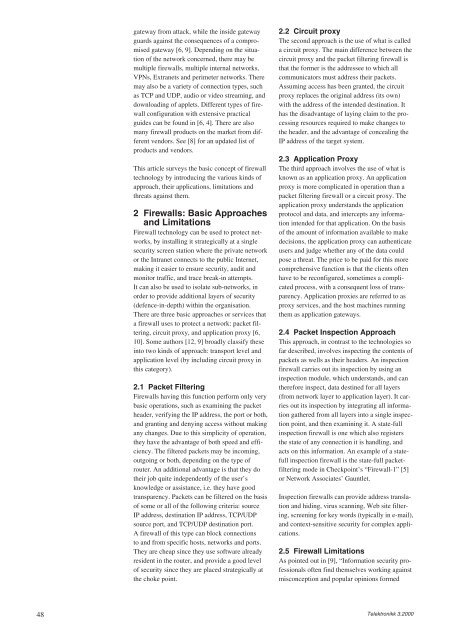Security - Telenor
Security - Telenor
Security - Telenor
Create successful ePaper yourself
Turn your PDF publications into a flip-book with our unique Google optimized e-Paper software.
48<br />
gateway from attack, while the inside gateway<br />
guards against the consequences of a compromised<br />
gateway [6, 9]. Depending on the situation<br />
of the network concerned, there may be<br />
multiple firewalls, multiple internal networks,<br />
VPNs, Extranets and perimeter networks. There<br />
may also be a variety of connection types, such<br />
as TCP and UDP, audio or video streaming, and<br />
downloading of applets. Different types of firewall<br />
configuration with extensive practical<br />
guides can be found in [6, 4]. There are also<br />
many firewall products on the market from different<br />
vendors. See [8] for an updated list of<br />
products and vendors.<br />
This article surveys the basic concept of firewall<br />
technology by introducing the various kinds of<br />
approach, their applications, limitations and<br />
threats against them.<br />
2 Firewalls: Basic Approaches<br />
and Limitations<br />
Firewall technology can be used to protect networks,<br />
by installing it strategically at a single<br />
security screen station where the private network<br />
or the Intranet connects to the public Internet,<br />
making it easier to ensure security, audit and<br />
monitor traffic, and trace break-in attempts.<br />
It can also be used to isolate sub-networks, in<br />
order to provide additional layers of security<br />
(defence-in-depth) within the organisation.<br />
There are three basic approaches or services that<br />
a firewall uses to protect a network: packet filtering,<br />
circuit proxy, and application proxy [6,<br />
10]. Some authors [12, 9] broadly classify these<br />
into two kinds of approach: transport level and<br />
application level (by including circuit proxy in<br />
this category).<br />
2.1 Packet Filtering<br />
Firewalls having this function perform only very<br />
basic operations, such as examining the packet<br />
header, verifying the IP address, the port or both,<br />
and granting and denying access without making<br />
any changes. Due to this simplicity of operation,<br />
they have the advantage of both speed and efficiency.<br />
The filtered packets may be incoming,<br />
outgoing or both, depending on the type of<br />
router. An additional advantage is that they do<br />
their job quite independently of the user’s<br />
knowledge or assistance, i.e. they have good<br />
transparency. Packets can be filtered on the basis<br />
of some or all of the following criteria: source<br />
IP address, destination IP address, TCP/UDP<br />
source port, and TCP/UDP destination port.<br />
A firewall of this type can block connections<br />
to and from specific hosts, networks and ports.<br />
They are cheap since they use software already<br />
resident in the router, and provide a good level<br />
of security since they are placed strategically at<br />
the choke point.<br />
2.2 Circuit proxy<br />
The second approach is the use of what is called<br />
a circuit proxy. The main difference between the<br />
circuit proxy and the packet filtering firewall is<br />
that the former is the addressee to which all<br />
communicators must address their packets.<br />
Assuming access has been granted, the circuit<br />
proxy replaces the original address (its own)<br />
with the address of the intended destination. It<br />
has the disadvantage of laying claim to the processing<br />
resources required to make changes to<br />
the header, and the advantage of concealing the<br />
IP address of the target system.<br />
2.3 Application Proxy<br />
The third approach involves the use of what is<br />
known as an application proxy. An application<br />
proxy is more complicated in operation than a<br />
packet filtering firewall or a circuit proxy. The<br />
application proxy understands the application<br />
protocol and data, and intercepts any information<br />
intended for that application. On the basis<br />
of the amount of information available to make<br />
decisions, the application proxy can authenticate<br />
users and judge whether any of the data could<br />
pose a threat. The price to be paid for this more<br />
comprehensive function is that the clients often<br />
have to be reconfigured, sometimes a complicated<br />
process, with a consequent loss of transparency.<br />
Application proxies are referred to as<br />
proxy services, and the host machines running<br />
them as application gateways.<br />
2.4 Packet Inspection Approach<br />
This approach, in contrast to the technologies so<br />
far described, involves inspecting the contents of<br />
packets as wells as their headers. An inspection<br />
firewall carries out its inspection by using an<br />
inspection module, which understands, and can<br />
therefore inspect, data destined for all layers<br />
(from network layer to application layer). It carries<br />
out its inspection by integrating all information<br />
gathered from all layers into a single inspection<br />
point, and then examining it. A state-full<br />
inspection firewall is one which also registers<br />
the state of any connection it is handling, and<br />
acts on this information. An example of a statefull<br />
inspection firewall is the state-full packetfiltering<br />
mode in Checkpoint’s “Firewall-1” [5]<br />
or Network Associates’ Gauntlet.<br />
Inspection firewalls can provide address translation<br />
and hiding, virus scanning, Web site filtering,<br />
screening for key words (typically in e-mail),<br />
and context-sensitive security for complex applications.<br />
2.5 Firewall Limitations<br />
As pointed out in [9], “Information security professionals<br />
often find themselves working against<br />
misconception and popular opinions formed<br />
Telektronikk 3.2000

















